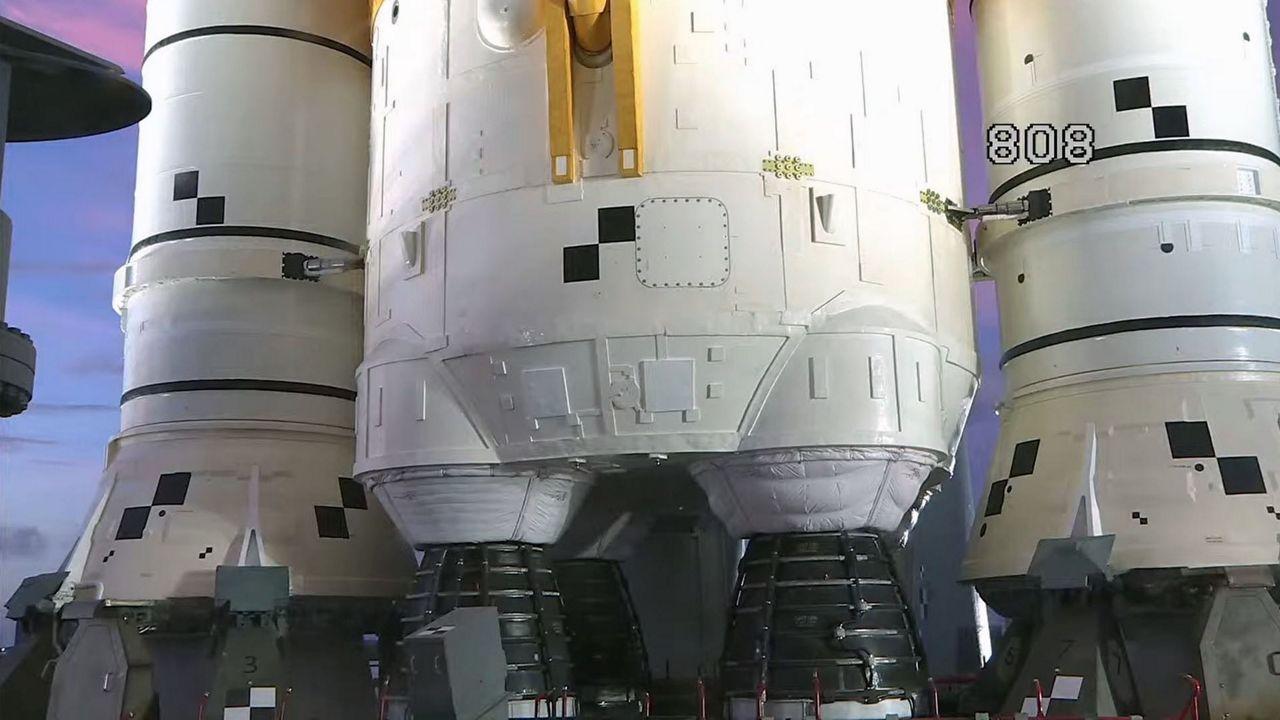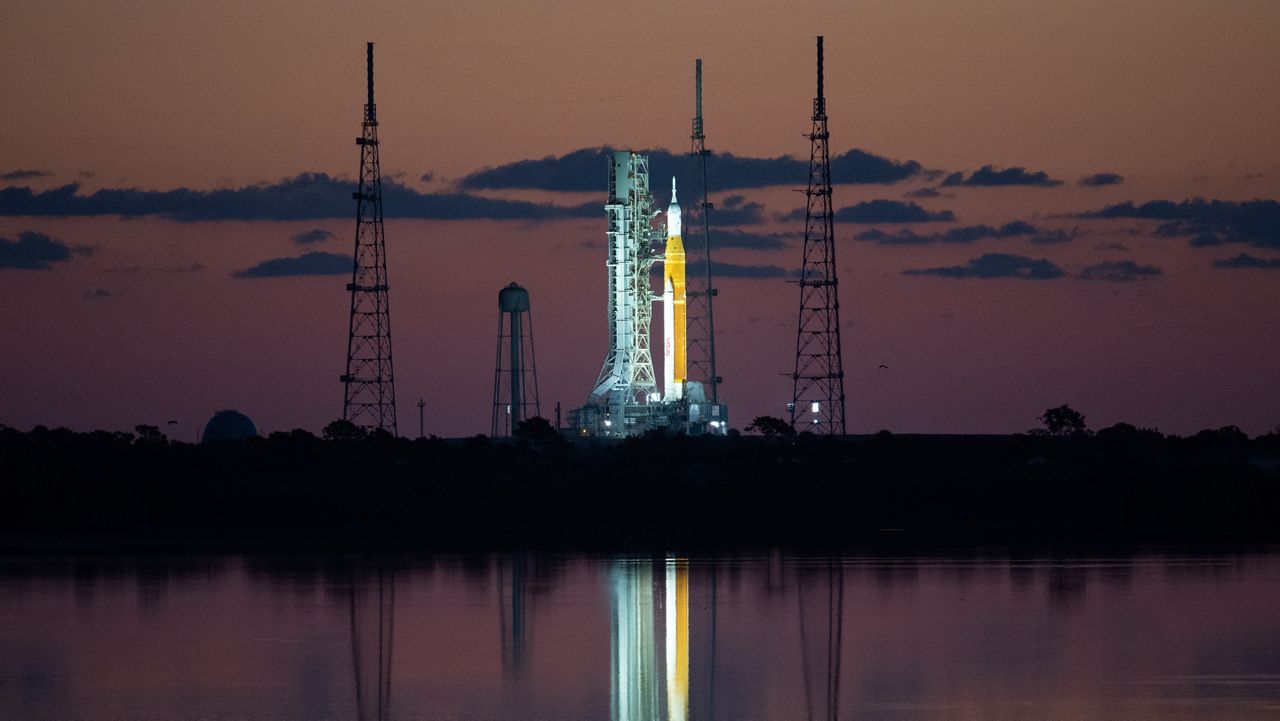KENNEDY SPACE CENTER — Despite scrubbing the Artemis I launch on Monday due to engine-related issues and other factors, NASA announced that it will go ahead with the launch for Saturday.
What You Need To Know
- A series of issues came up during NASA's attempt to launch the Artemis I on Monday
- A team of engineers have been going over the rocket and data
- NASA said the issues that prevented Monday’s launch are being worked on
- RELATED coverage: NASA: 'Engine bleed,' other factors postpone Monday's Artemis launch
During a teleconference on Tuesday evening, NASA's Artemis Mission Manager Mike Sarafin said the launch will go ahead.
"And we also agreed to move our launch date to Saturday, Sept. 3," said Sarafin of NASA's decision to go forward with the launch. The two-hour launch window is scheduled for 2:17 p.m. EDT. If it has to be scrubbed again, the next launch attempted will be on Monday, Sept. 5.
During the teleconference, Mark Burger, the launch weather officer of 45th Weather Squadron, said that the launch weather is at 40% and while he admitted that was not the best percentage, he says it is a "pretty good opportunity for launch on Saturday."
The Artemis I mission’s Space Launch System rocket and its Orion spacecraft are still sitting on Launch Pad 39B at the Kennedy Space Center, waiting for its 42-day mission to the moon and back.
Originally, the launch was supposed to take place at 8:33 a.m. EDT on Monday.

A series of issues
A series of issues cropped up during the early morning hours on Monday as NASA was preparing to fuel the massive super rocket called the Space Launch System. Besides storms in the area that delayed the start of fuel-loading operations, teams could not get one of the rocket’s four RS-25 engines (engine 3) at the right temperature range needed for liftoff, NASA officials said.
“Engine 3 is not properly being conditioned through the bleed process, and engineers are troubleshooting,” NASA stated at the time.
NASA managers said they believe there is nothing wrong with engine 3, despite it not cooling to the correct temperature.
NASA officials explained that the engines need to be thermally conditioned before the subzero fuel begins flowing through them for liftoff. The engines are prepared for this “by increasing the pressure on the core stage liquid hydrogen tank to route, or ‘bleed’ as it is often called, a portion of the approximately minus 423 F liquid hydrogen to the engines,” NASA stated.
The Space Launch System rocket needs 730,000 gallons of super-cooled liquid hydrogen and liquid oxygen for liftoff.
But poor weather and engines not being in the right temperatures were not the only issues plaguing the launch, such as a liquid hydrogen leak.
Derrol Nail, of NASA’s communications team, said early Monday that officials got a warning that there was a “higher than acceptable” amount of liquid hydrogen in an area that covers the connections into the rocket. These sensors are designed to go off if any potential leaks are detected, he said.
Despite the liquid hydrogen leak, Sarafin said on Tuesday during the teleconference that the NASA team was able to fully load the rocket with fuel, but it was the thermal conditions that are required for the launch that could not be met. He said that there had been a risk of something like this happening.
“That was something we knew about coming out of the agency flight readiness review," he said. "That we would demonstrate that for the first time in the launch countdown, and we knew it that would be a risk to being able to successfully attempt to launch that day."
Sarafin said NASA teams have gone over the data collected from the launch attempt and have agreed to work on the issues that prevented the liftoff, such as the decision to change their loading procedure and start the engine chill down earlier.
He also went on to say that the team will address the leak at the tail service mast umbilical on the hydrogen side of the 8-inch quick disconnect. But he later said that they want to make sure of everything before they launch.
“We are going to try to launch on the third,” Sarafin said, adding that if NASA cannot condition the engines to where they need to be, “we are not going to launch.”
Charlie Blackwell-Thompson, Artemis I's launch director, said NASA is going over information and will check for leaks.
Blackwell-Thompson said what held them up was the late start of fueling due to the weather. She said it may have been possible to resolve the issues and liftoff within the two-hour launch if it had not been for the weather delay, but admitted she was speculating
In addition, NASA stated engineers were assessing what appeared to be a crack in one of the flanges on the core stage tank.
“The flanges are connection joints that function like a seam on a shirt, are affixed at the top and bottom of the intertank, so the two tanks can be attached to it,” NASA had described.
Past issues
The Artemis I mission (one of three planned missions to get humans back to the moon) has faced issues.
In April during a wet dress rehearsal for Artemis I, a leak was discovered on the tail service mast while liquid hydrogen was being loaded into the rocket’s core stage tank, NASA stated.
As engineers were working to repair the leak, it was found that a collet — which is found inside the wall of the rocket’s engine section and holds an umbilical plate on — had some loose fasteners.



